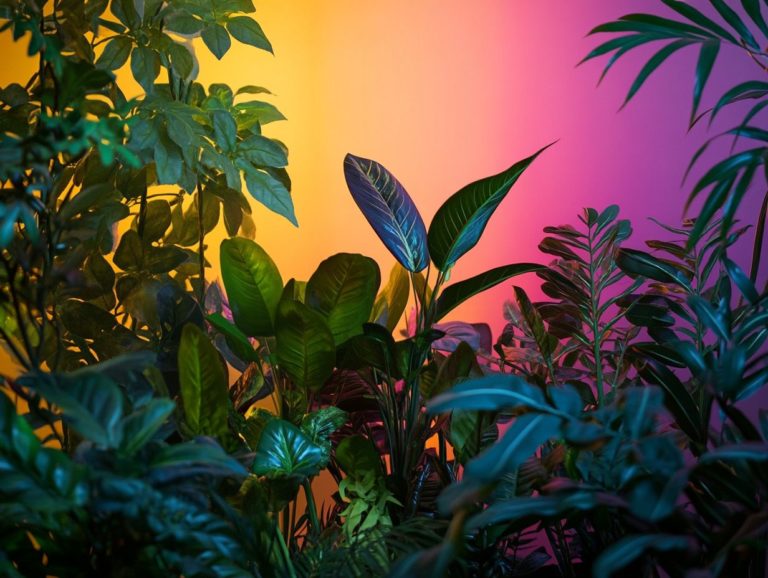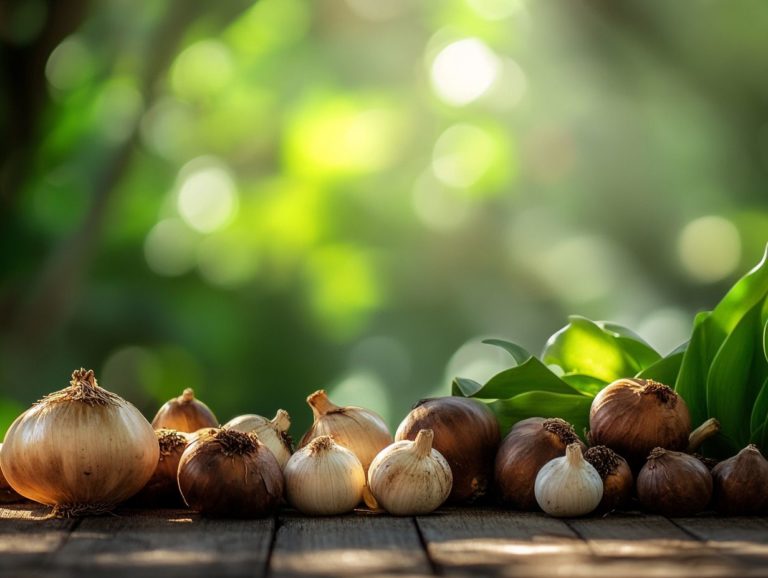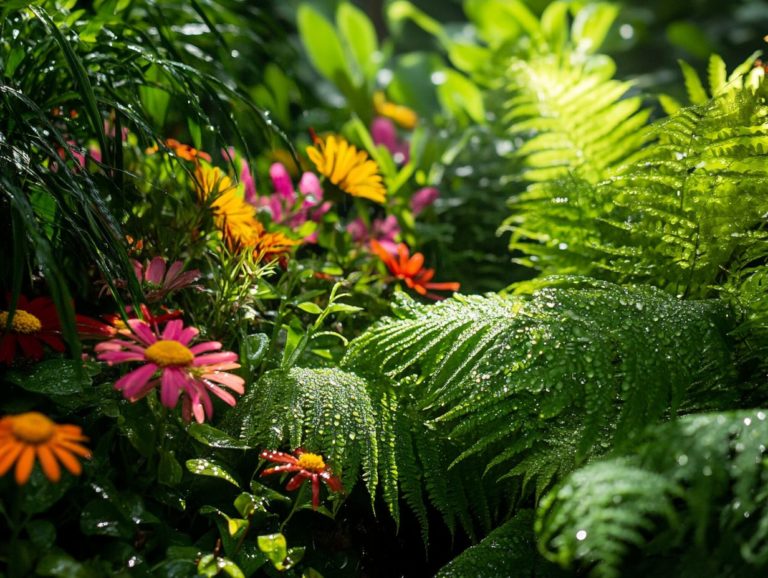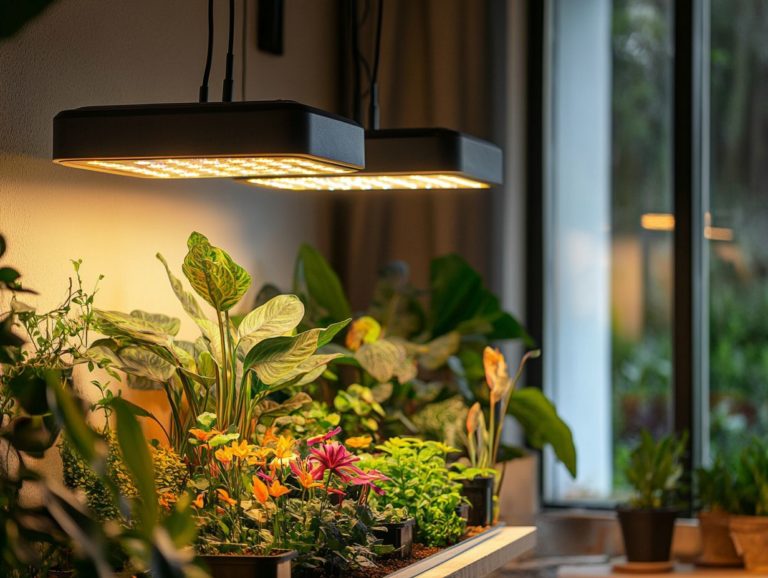Choosing the Right Light for House Plants
House plants have the remarkable ability to elevate any space. Their vitality hinges on optimal lighting conditions.
Recognizing how various light types impact your plants can mean the difference between lush, thriving greenery and sad, droopy leaves.
This article delves into an array of light sources, both natural and artificial. You’ll find practical tips to identify the best lighting for your specific plants.
You’ll also discover how to spot signs of light-related challenges and address them with ease.
Get ready to create the perfect home for your leafy friends!
Contents
- Key Takeaways:
- Understanding Light Requirements for House Plants
- Determining the Best Light for Your Plants
- Types of Lights for House Plants
- How to Properly Use Light for House Plants
- Troubleshooting Common Light-related Issues
- Frequently Asked Questions
- What factors should I consider when choosing the right light for my house plants?
- What are the different types of light that house plants need?
- Can I use artificial light for my house plants?
- How do I know if my house plant is getting enough light?
- Can I supplement natural light with artificial light for my house plants?
- How long should I leave the lights on for my house plants?
Key Takeaways:
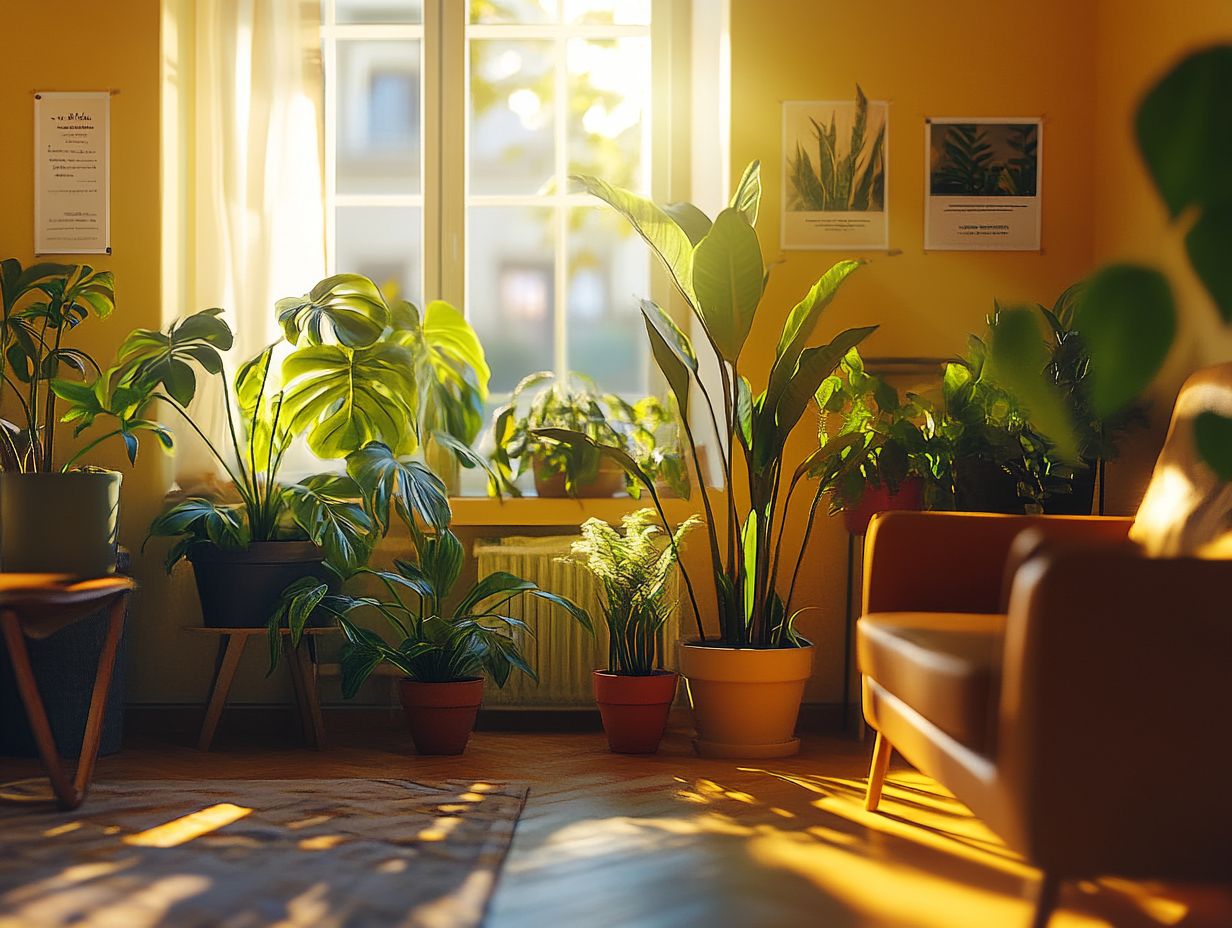
- Understanding your house plant’s light requirements is key to their growth and health.
- Consider factors like duration, intensity, and direction when determining the best light source for your plants.
- Natural light sources are ideal, but if unavailable, artificial lights like LED and fluorescent can also be used effectively for house plants.
Understanding Light Requirements for House Plants
Understanding the light requirements for your houseplants is crucial for their growth. Each plant species has unique needs based on light intensity, duration, and spectrum.
By grasping these requirements, you can choose the ideal light source, whether it be natural sunlight or artificial lighting. Implementing light management practices like optimal placement and intensity can greatly boost photosynthesis and enhance overall plant health.
This guide will lead you through the essentials of crafting the perfect lighting conditions for your houseplants, with a focus on energy efficiency and attentive care.
Different Types of Light and Their Effects
Different types of light have unique effects on plant growth. It’s essential for you to choose the right light source for your indoor plants.
When evaluating your options, consider not only energy efficiency but also how each type of light supports various growth stages. LED lights are especially effective during the flowering phase; their adjustable spectrum meets the specific needs of flowering plants, encouraging more vibrant blooms.
On the other hand, fluorescent bulbs shine during the early stages, offering gentle light that helps seedlings thrive without any risk of burning.
While incandescent lights may seem appealing due to their warmth, their inefficiency can lead to higher energy costs and limited support for plant growth. By understanding these characteristics, you can strategically select lighting solutions that promote optimal health for your plants.
Determining the Best Light for Your Plants
Determining the best light for your plants requires a keen assessment of their specific needs. Different plant species flourish under varying circumstances, so grasping the optimal light intensity and duration is crucial.
Whether you re nurturing succulents, flowering plants, or herbs, your light management strategy will directly impact photosynthesis and their overall health.
Moreover, paying attention to light coverage and placement will create an ideal environment for your indoor gardening pursuits.
Here are practical tips to help you optimize light conditions for your plants’ specific needs.
Factors to Consider
When determining the best light for your plants, consider several key factors to ensure optimal growth and health. Light intensity is fundamental; different plants thrive under varying levels of brightness. The duration of light exposure is also crucial for their growth cycles.
Proper placement of your light sources is essential. This ensures that all parts of the plant receive adequate light. By managing indoor light levels and plant selection effectively, you enhance energy efficiency, making your indoor gardening journey more sustainable.
Understanding these elements helps you create the ideal environment for your plants. It s vital to think about the light spectrum your plants receive, as different types of light can promote distinct growth stages, such as flowering or leaf production. Using full-spectrum lights can mimic natural sunlight, fostering more robust growth.
Implementing timer systems will help maintain consistent light schedules. This ensures your plants receive the perfect amount of light each day. By keeping these factors in mind, you support healthy plant growth and optimize your energy consumption, making your gardening practices more eco-friendly and efficient.
Types of Lights for House Plants
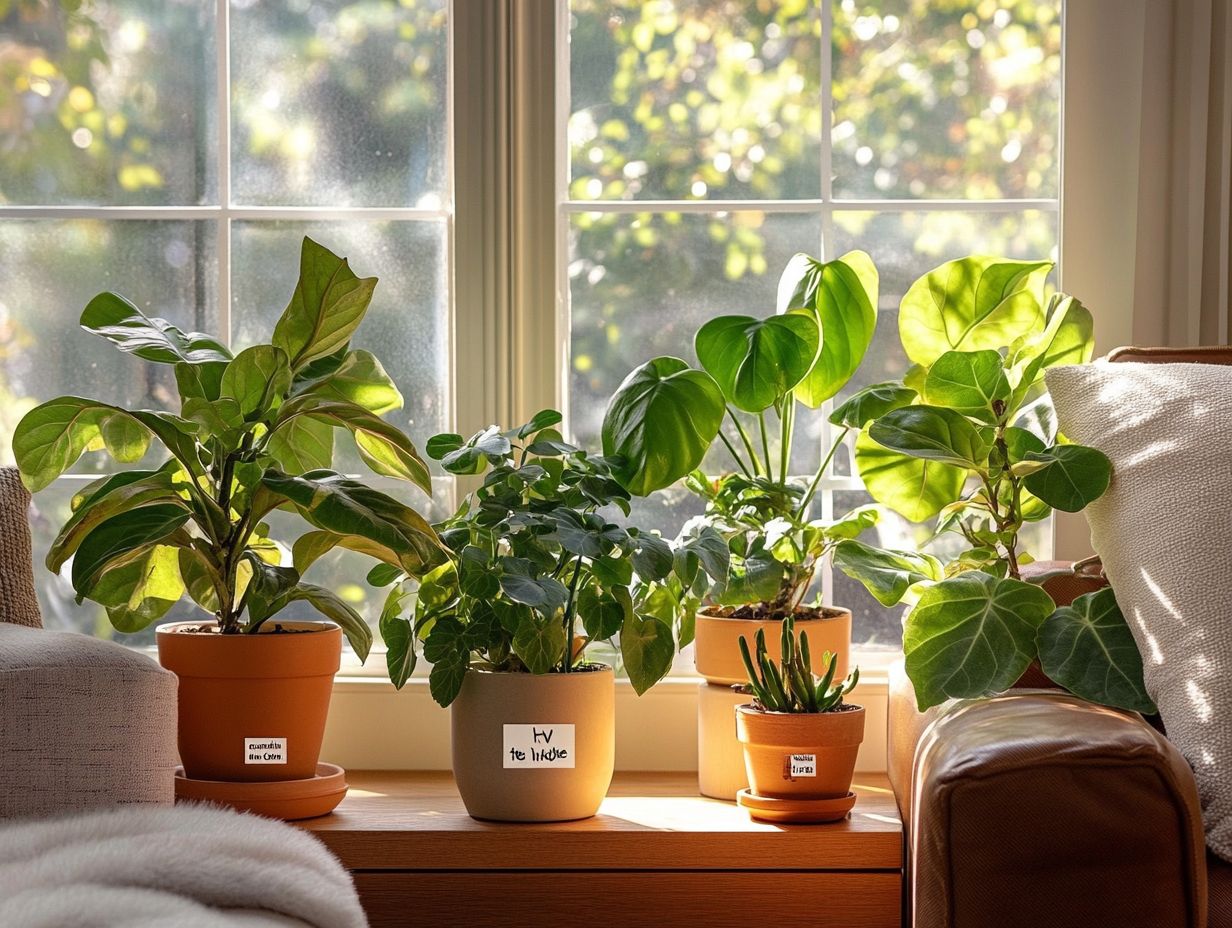
When it comes to illuminating your houseplants, understanding the different types of lighting available is crucial for optimal plant care. Natural light sources like windowsills and skylights are excellent starting points. However, they may not always meet the specific needs of every plant species.
On the other hand, artificial light sources such as LED lights, fluorescent bulbs, and incandescent lights provide versatile options for promoting healthy growth indoors. Choosing the right fixtures tailored to your unique indoor gardening environment is essential. You can learn more about how to manage light for tropical plants, which can significantly enhance the overall health and vitality of your plants.
Natural Light Sources
Natural light sources, especially sunlight, are essential for the growth of your house plants. They provide the spectrum needed for photosynthesis. To soak up the most sunlight possible, place your plants near windows or in sunrooms.
To make the most of these natural light sources, evaluate the quality and intensity of sunlight in different areas of your home throughout the day. For instance, tropical plants tend to flourish in bright, indirect light, while succulents and cacti thrive in direct sunlight for much of the day. For more guidance on this, check out our tips on how to position plants for best light.
Understanding the specific light requirements whether full sun, partial shade, or low light enables you to position your plants strategically for optimal growth. Regularly rotating them helps prevent uneven growth and ensures that every side gets a fair share of sunlight.
Thoughtfully analyzing and adjusting light placement can significantly boost the health and vibrancy of your indoor plants.
Artificial Light Sources
Artificial light sources are critical for indoor gardening, granting you flexibility and control over the light conditions for your houseplants.
By using various types of lights, you can customize your setup to meet the specific needs of different plant species and their growth stages. For example, LED lights not only save energy but also allow you to adjust the light spectrum for optimal plant growth, supporting both flowering and vegetative phases.
Fluorescent lights can be beneficial for nurturing young plants, though they may require frequent replacements to maintain their efficiency. While incandescent lights are easily accessible, they can lead to heat stress in more sensitive plants, making them less than ideal.
Understanding the advantages and limitations of each type of lighting is essential for maximizing growth potential and ensuring the robust development of your plants.
How to Properly Use Light for House Plants
To properly use light for your houseplants, it’s essential to master how to manage different factors, such as light placement, intensity, and schedules, to create the perfect growth environment.
Thoughtful light placement guarantees that each plant receives the light it needs. Adjusting the intensity caters to specific requirements and helps avoid issues like damage to leaves from too much light.
Establishing a consistent light schedule mimics natural cycles, which is crucial for promoting healthy photosynthesis and overall plant development.
Mastering these techniques can significantly boost the vitality of your houseplants. Your plants will thrive beautifully with the right care in your indoor space.
Placement and Timing
Light placement and timing are important parts in your quest for successful houseplant care, as they directly impact growth and overall health.
Positioning your plants in optimal spots where they can bask in the right amount of light throughout the day is essential. Establishing a regular light schedule helps mimic the natural day-night cycle, which is vital for promoting photosynthesis and healthy growth.
By understanding these factors, you can create the perfect environment for your indoor plants, enhancing their vitality and resilience.
Take the time to observe how each plant responds to the light; this careful attention can reveal patterns that guide your future placements. Using grow lights strategically is a savvy way to supplement natural sunlight, especially in shadier corners of your home.
Rotating your plants occasionally ensures that all sides receive equal exposure, preventing uneven growth.
The overall health of your plants, along with their cycles of blooming, can significantly benefit from a well-thought-out light management strategy. Focus on keeping light consistent and knowing when to make adjustments, and you can nurture a thriving indoor garden that flourishes through every season.
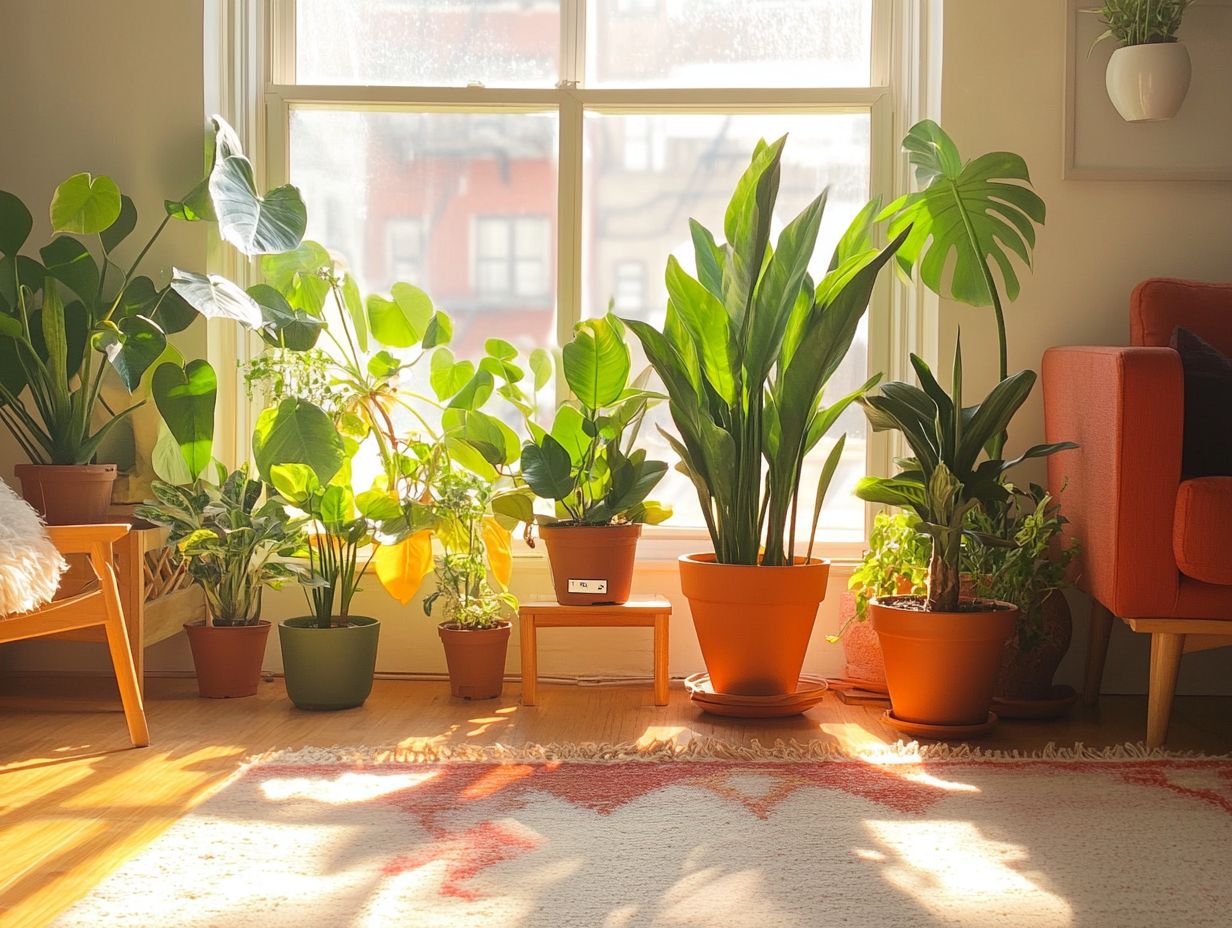
Troubleshooting light-related issues is crucial for ensuring the vitality of your houseplants and fostering their uninterrupted growth. By recognizing signs of inadequate light such as leggy growth or yellowing leaves you can pinpoint when it s time to adjust your light placement or consider a different light source.
On the flip side, too much light can also cause distress, manifesting as scorched leaves or stunted growth. Understanding these symptoms and taking appropriate corrective measures can effectively tackle light issues and elevate your plant care to new heights.
Signs of Inadequate or Excessive Light
Recognizing the signs of inadequate or excessive light is crucial for maintaining the optimal conditions for your houseplants. If your plants lack light, they may exhibit leggy growth, yellowing leaves, or an unsettling lack of flowers, all of which signal that they re stretching desperately toward the light.
On the flip side, too much light can lead to scorched leaves, browning tips, or stunted growth, indicating it s time to adjust the light intensity or reposition them. By understanding these signs, you can act swiftly, ensuring your plants thrive in their ideal environment.
Take, for example, a peace lily that may droop and fail to bloom if it’s not receiving sufficient light. In contrast, a succulent like an Echeveria could develop burnt edges if they receive too much direct sunlight. This highlights the importance of understanding each plant species’ specific light requirements and knowing how to choose the right bulbs for plants.
Practical steps you can take include adjusting the position of your plants perhaps moving them closer to a source of indirect sunlight or shielding them with sheer curtains to diffuse those harsh rays. This supports optimal plant illumination.
Regularly rotating your plants will also help ensure even exposure, promoting balanced growth. With careful observation, you ll be enabled to create the perfect environment tailored to the unique needs of your plants.
Tips for Adjusting Light Levels
Adjusting light levels is essential for ensuring healthy plants and effective gardening practices. By implementing ways to manage light for plants like moving your plants closer to natural light sources or selecting suitable fixtures for artificial lighting you can significantly enhance their growth conditions.
Using light meters allows you to measure light intensity, helping you tailor your setup for maximum energy efficiency. Understanding the light spectrum, or the range of light that plants use, will enhance your setup even further. For more information, check out this resource on understanding indoor plant light needs. With targeted tips for adjusting light levels, you can create an ideal environment that encourages your houseplants to thrive.
Knowing your plant’s light needs is key to success! Some plants flourish in bright, indirect light, while others prefer more subdued, low-light conditions. Utilizing LED lights and fluorescent lights can help you achieve the right balance. Additionally, choosing the right water for indoor plants is essential for their overall health. Experimenting with the positioning of your plants in relation to windows and artificial light sources can lead to impressive results.
Incorporating energy-efficient LED grow lights ensures your plants receive the necessary spectrum for photosynthesis the process plants use to convert light into energy without inflating your electricity bill.
Regularly adjusting the lighting based on seasonal changes or the growth stages of your plants guarantees that your green companions receive adequate illumination, fostering vibrancy and lushness throughout the year. Understanding the light output and beam angle ensures proper plant care. You can find more about identifying light needs of various plants to enhance your knowledge. Ultimately, a thoughtful approach to light management not only supports plant vitality but also contributes to sustainable gardening practices.
Frequently Asked Questions
What factors should I consider when choosing the right light for my house plants?
When choosing the right light for your house plants, consider the plant’s specific light requirements, the intensity and duration of light, light temperature, and the location of your plants in your home.
What are the different types of light that house plants need?

House plants typically need three types of light: bright, indirect light; medium light; and low light. Bright, indirect light suits plants that need high light levels, while medium light is suitable for those thriving in partially shaded areas. Low light is best for plants that excel in dim conditions.
Can I use artificial light for my house plants?
Yes, you can use artificial light for your house plants. LED grow lights are a popular choice as they provide a full spectrum of light and are energy efficient. However, fluorescent lights and incandescent lights can also be used, though they may not offer the same level of light as LED grow lights. Understanding different grow light types helps you select the best option for your plants.
How do I know if my house plant is getting enough light?
If your plant isn’t getting enough light, you may notice it becoming leggy or stretching toward the light source. The leaves may also turn yellow and drop. Conversely, if your plant is receiving too much light, the leaves may turn brown or appear scorched, indicating an imbalance in light intensity.
Can I supplement natural light with artificial light for my house plants?
Yes, you can supplement natural light with artificial light for your house plants. This is especially helpful during the winter months when natural light may be limited. Using a timer setting for your artificial lights can help regulate exposure. However, it’s important to choose the right type of artificial light and ensure that your plants aren’t exposed to too much light, as this can cause harm.
How long should I leave the lights on for my house plants?
The duration of light needed for house plants varies depending on the type of plant and its specific light requirements. Most plants thrive with 12-14 hours of light each day, but some may require more or less. It’s important to research your specific plants to determine their ideal light schedules.
Experiment with your light setup today and watch your plants flourish!

